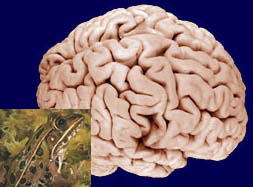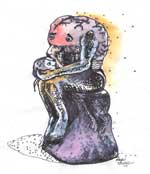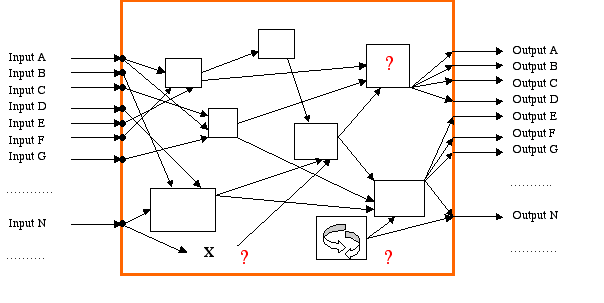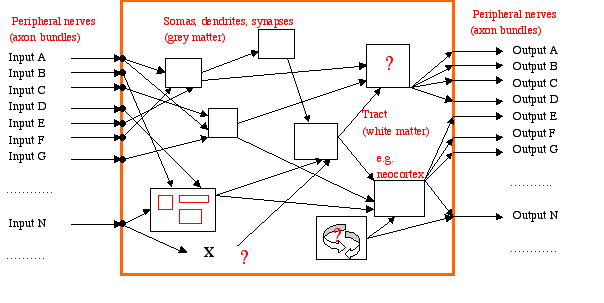Serendip is an independent site partnering with faculty at multiple colleges and universities around the world. Happy exploring!
Brain Behavior Institute - Session 5

|
BRAIN AND BEHAVIOR INSTITUTE 2008 |

|
Neurons and Nervous System Architecture:
Autonomy, Variability, Feedback, and Exploration
Review
- Making a blog is a lot easier than I had thought ... Grace
- I felt more comfortable using the web today! .. Judith
- We live in a litigious society; teachers can lose their jobs if children are endangered by use of an unblocked Internet ... Joyce
- one of the most important things we need to teach our students is critical thinking vis a vis electronic resources; i.e. how to evaluate the information they get electronically. We need to be careful to do the same thing ... Carol
- Creating one's own simulations is quite challenging. It is a good reminder of how it feels to be a student struggling with a new concept ... Carol
- I know that some people might find the notion of the brain being everything as dehumanizing, as somehow making us seem less than we think we are, but I don't think you need to look at it that way ... Carol
- i just want a story that allows for "free will". still considering the evidence ... Wil (and what about consciousness? society? culture? "reality" outside ourselves?)
- The nervous system generate activity by it self ... Which is letting me understand that students learn by hands on, rather than pencil and paper ... Bernadine
- Because each student is different, internal variability, it implies that teaching to a general group can be ineffective. But then how do you teach so that you meet the needs of each individual student without compromises their education due to limited time? ... Penn
- how do I as an effective educator help my first category of students so that their output will significantly reflect my input? ... Tola
- It seems to me that we should start with the burning questions on their minds (depression, romance, stress, sports - etc) and then tie them back to hormones ... I know that I wouldn't necessairly be excited for a class called seretonin and dopamine. But a class called depression and love. Now that's exciting! ... Adi
- Making a blog is a lot easier than I had thought ... Grace
- I felt more comfortable using the web today! .. Judith
- We live in a litigious society; teachers can lose their jobs if children are endangered by use of an unblocked Internet ... Joyce
- Creating one's own simulations is quite challenging. It is a good reminder of how it feels to be a student struggling with a new concept ... Carol
 |
Helps with
|
Beginning to get some answers to new questions
 |
|
The Signals
- Action potentials (more this afternoon), receptor potentials, synaptic potentials
- Importance of inhibition as well as excitation
- Chemical sensitivity
- Equivilence of signals in all cables, problem of interpretation
- Acting and thinking both take time
- All behavior and experiences are patterns of action potentials?



Comments
Crossed Wires
Although today was rather cloudy in my mind, to me the big picture is that there are multiples factors that contribute to a child’s brain capacity, actions and behaviors. Six hours a day is not enough time to reroute or hot wire a child’s brain. Is it enough time to bend it for our intents and purposes? As an educator it should be our goal to identify and deal with all factors contributing to behavior.
Re-Wiring
Animal intelligence
In anticipation of tomorrow's lesson, I think it worth asking in what ways are our brains similar to animals and in what ways are they different?
My own sense is that we tend to over-estimate the ways are brains are different from animal brains. Or maybe its just that we like to think that we are smarter than we are ( :
http://scienceblogs.com/neurophilosophy/2008/06/5_amazing_feats_of_animal_intelligence.php
Masking Uniqueness
Paul suggested earlier that there will never be another brain like ours due to the potential patterns of ‘architecture’ created when using 1013 neurons as construction material. Therefore I understand why teachers are questioning how we can reach and teach such an abundance of unique individuals. My plan over the last several years has been to develop a ‘differentiated classroom’, a methodology that tends to support reaching each unique student.
However when JR Lewis (Julia) indicated in her blog that she worked with an Alzheimer’s patient who endeavored to hide his confusion so as to appear ‘normal’ within what must have been a terrifying reality for him; I began thinking about the deeper problem in high school of teens who recognize their unique way of viewing the world and who try to suppress it to reflect the teen norm.
Just like the random fireflies or cars that Paul throws into a program and eventually form a pattern so do our students (for the most part) come to a consensus of behavior. That group-behavior is shaped in a variety of ways dependent on the accepted culture of the school which can sometimes be anti-adult. I’ve seen some of my classes veer both ways. Last year I had one class that was constantly and oppressively oppositional. Interestingly, the same teaching methodologies were applied to other classes that were very cooperative. I attributed this blatant abnormality to one (eventually transferred) student. The bizarre aspect to me about this oppositional class was that when I interacted with only individuals all of them were cooperative and extremely personable.
I realize now that the beginning of the year is the critical time to find the “norm setters” of class culture and that the manipulation of these students will make or break positive culture. My speculation is that he class last year followed the wrong ‘norm-setter’ and were so personable individually as if to apologize to me for the group’s behavior.
Though I’ve always recognized that this phenomenon exists; it was our Brain & Behavior workshop and the series of blogs that ‘fired up my neurons’ to formulate this theory and hopefully a consequent management plan (experiment). A few norm-setters will begin to emerge right away in the beginning of the year so I need to formulate a plan to ‘sculpt’ them. I would want to bring the positive norm-setters to a position of power in their influence over the others however I must proceed in a way that the teens won’t notice my guidance (interference?...experiment?).
In past years I placed more focus on understanding the one or two children in each class who never follow the crowd and I have either celebrated their confidence or agonized over their inability to make friends. Three years ago I learned about Asperger Syndrome and how it typically affects high school students. Sadly, the teens who demonstrate the Asperger symptomology - though they deeply want to change - seem to be incapable of masking their uniqueness and thus never reach acceptance.
Great post
I think the idea of norm setters is a very strong one. As is the idea that group behaviors start to show patterns. I am curious what you plan to do with the norm setters.
One of the ways that we deal with this in the informal education world is to set up structured social interactions to address social dynamics. I am not saying it always works, but in the camp world we are in the buisness of trying to create positive group culture. I would be curious to think about what new tools we have at our disposal to accomplish this goal.
Positive Group Culture
My draft plan is posted on my blog. I did not iclude details but I created an outline incorporating methodologies that I currently have in place. I am interested to hear about the methods you used in the camp.
Thanks for your helpful response!
Disinhibiting education!
One thing important to keep in the back of teacher’s minds is both things that not only excite but also inhibit student learning. With that said, teachers should make a conscious effort to minimize or (ideally) eliminate the “boring” found in the classroom/lesson/etc.
Pass successes, which I feel can never be implemented enough, include but is not limited to:
Thinking about this and flipping a question Grobstein proposed once earlier this summer; must one (student) adapt in order to learn? The answer to this question as to the original question (must one learn in order to adapt) when adapt refers to the individual’s mental capabilities/limitations or social behavior is no.
This then makes me think about Grobstein's proposition of not teaching students the knit picky details of a certain field of study unless the student is in an advanced course, deliberately taking the course to specialize in that subject. Instead, Grobstein suggests teaching students the most basic information as well as information relevant to other disciplines and life situations; learning how it functions for/in the rest of the world, that will further the students inquiry skills and better their ability to grapple with real-life challenges.
Beatles song: W/in You and W/out You
The title just suddenly popped into my head -- obviously generated by a bunch of memory neurons stuck in the '60s, a time when people were seemingly using chemicals to rewire how their sensory neurons were connected. For instance, LSD supposedly could cause users to "see sounds" and "hear colors."
Actually, there is a similar problem concerning "where connections are made" being considered in the research being done to reverse or "cure" paralysis. Some researchers are looking ahead to the time when we can get the axons to regrow across the glial scar (the lesion) that is currently believed to prevent regrowth at this time. The big question is: Once the axons regrow and make connections on the other side of the scar, will these connections actually be workable? Or will the axon that used to enervate (activate) the left big toe now be connected to the right calf? How much relearning will be required . . . and will a person be able to do it?
From the work that has been done in the rat model, it would seem that this will not be a problem. However, until the same degree of success is achieved in humans . . . .
Only peripherally (pun intended) related to this, I think, is that there is more and more evidence that the brain is constantly rewiring and generating new connections. This is where learning occurs, right? Is it true then that the more connections we have made, the faster we can retrieve material b/c it's like cross-indexing . . . or is it the more we have learned . . . or both? Do more similar connections mean that we have learned material more deeply . . . or that that the connections are simply redundant?
Will we be "given" the answers tomorrow? . . . or would that make us too much like simple med students?
brain and behavior
Using the web to help students learn is more interactive than not.The brain is built to explore.There is plenty room in the brain for exploration.
The Brain as an action potential
The brain is a fasincating action potenial that is unique and wonderfully made. Understanding my brain is difficult but I have a better understanding of how unique it is and how uniquely we are made. The brain and how it functions is very important to understand. I think I have a better understanding of how I perceive things and how I inhibit other things. It was fascinating to find out how our brain and the neurons can interact without our input. Input and output doesn't always seem to equal each other; is there a reason for this? I don't fully understand how the neurons and action potential patterns work but I was really interested in how they make people unique. I am also interested in how chemicals can interfere or inhibit one area and excite another area especially in the disease called Lupus.
nervous system
I was interested in gaining more info about neurotransmitters and their function.The inhibitory and excitory synapes needs cables to function,which lead to patterns of action potential.
Reducing stimuli
We also might want to
Action Potential
The variety of inhibitory and synaptic action potentials is amazing. The idea that each of us have such differrent brains makes me wonder how we manage to successfully educate such a diversity of brains?
Are there specific adaptations in classroom environments work for most students? Do we rely on trial and error to help deterrmine what works for the ADD and autistic spectrum students?
A cool way of presenting some complicated stuff---
I like the headless chicken metaphor as a way to help us to understand the importance of inhibitory synapes/neurons. Although it seems to lead to the conclusion that a chicken who never had a head with be running around randomly all the time because of the 'action potentials' coming from its spinal cord (though I recognize that the brain might be needed for other things!)
The conversation about the internal generation of action potentials makes me think of schizophrenics, who can't discrimminate between an internal and an external source of information, hence their audio and visual hallucinations. I think this explanation of their psychosis is much kinder, and more accurate.
This is tough stuff to understand and I have read and seen it many times, each time picking up a little peice more of understanding- though I am not there yet.
One very funny and enjoyable article that I found last night while researching brain imaging. It's about the field of 'neuromarketing' which I think means reading our minds to find out what we will buy. Click here for 'My Amygdala, My Self'
Great article
Thanks Carol, that was a good read...very funny!
All kidding aside though, with mind-mapping, are we pushing the boundaries by allowing mechanical mind readers to perhaps invade our private thoughts?
Very funny!
Thank you for sharing that. I laughed out-loud about his wife's line. Describes my experience with my girlfriend very well.
I am also amused by the fact that we are willing to do anything in this country to turn a buck. A neuro marketing agency? If you hooked up my brain while I was reading the article it would have showed a combination of amusement, revulsion and an intense desire to start watching the third season of the wire.
Interesting insight. My
nervous system
It was interesting to gain a better understanding of how neurotransmitters work.The concept of inhibitory and excitory synapses acrooss cables enhanced patterns of action potential.I still need more info about negative and positive changes in the membrane.
Brain Behavior Institue 2008
Brain............. boxes all the way down and all the way up.
What's going on in my mind as Paul gave us the impression that the brain is a bunch of boxes within a larger box is that we may only be "scratching the surface" of the matter with reference to our investigation and research as a whole.
I'm having this impression because from our discussions so far, it gets to a stage where we stop investigating the boxes as we go inwards (towards the neurons) and also as we go outwards (into the universe as a whole).
To be more explicit, by outwards I mean going out of the brain (as a box) into it’s immediate environment and further out into the rest the world, then our solar system, our galaxy, intergalactic realm, universe and so on without any end in site.
The whole things is quite exciting and as Paul said we can't really get to the end of anything, we just have to continue investigating (both outwards and inwards) without really hoping to have any end in site. This is science and the essence of our existence.
Inhibitions and student behaviors
With the "headless chicken" running around, I am beginning to think that my students are the way they are because they have some inhibitions being disabled in them. In other words does that mean that the "normal" kids are those operating under regular inhibitions?
Tola
The brain and neuron activity?
The real brain {nervous system} to me, has more of the self-operating boxes, those without any input to create output, than the boxes that accept input to create output. So then I believe te brain is not just a box like that. It is interesting to note that how we put things together matters more than what we actually put together.
Since all animals have brains/ spinal cords, but only mammals have the neocortex, does that explain the differences between the behaviors of all animals?
How about the story of not using our brain to the fullest capacity? I would have prefered to believe this story so that I can believe that my students have a lot of room for improvement. If the other side is true then we will begin to make excuses for our laxities, our weaknesses.
Interneurons are supposedly about 99.99% of the the neurons. Does this mean that people that are slow in processing information or any form of input have defective interneurons or what?
Why does the box metaphor stop at neurons?
Why does the box metaphor stop at neurons? What breaks down at smaller scales. The next level of reduction is molecules or perhaps groups of molecules, then molecules, then atoms. What about groups of molecules make the metaphor less useful?
The components of the Box metaphor:
Let's look at groups of molecules. They don't have clear boundaries, which makes everything else hard to define. So,
Let's look at molecules. They have boundaries, but again fuzzy depending on the scale. They have other working parts = atoms. Molecules have inputs? Yes, electrons and other energy forms like photons and gamma rays etc. Do molecules have outputs? Can molecules self-generate outputs? Or do molecular outputs always rely on inputs? They sometimes give off forms of energy? Energy is a causal force that all matter interacts with.
Or, is this line of thought not very useful? Why? Again, why is the box metaphor not useful at smaller levels below the cell?
The model changes at the nano level.
At the nano level different rules apply. For example Gold is not longer gold color. The physical and chemical properties of matter can be different and so you can not continue to use the same model at nano-scale which BTW makes the investigation of nano materials extremely fascinating!
http://cnst.rice.edu/nano.cfm
Well Will...
Although not explicitly relevant to the discussions held in this institute, and therefore not mentioned, this discussion can very well be incorporated if not in your institute Will then in your Bio 103 course when discussing the magnitude of scale views.
Well Will....
Investigating the next level of reduction is very valuable for many reasons, one being because it brings our attention to the miniscule (in reference to size) uniqueness of Energy; its movement is not contingent on boundaries, whether they are present, fuzzy, or absent. This leaves us with the question, what the hell is Energy, a great lesson to segway into.
Although not explicitly relevant to the discussions held in this institute, and therefore not mentioned, this discussion can very well be incorporated if not in your institute Will then in your Bio 103 course when discussing the magnitude of scale views.
Post new comment